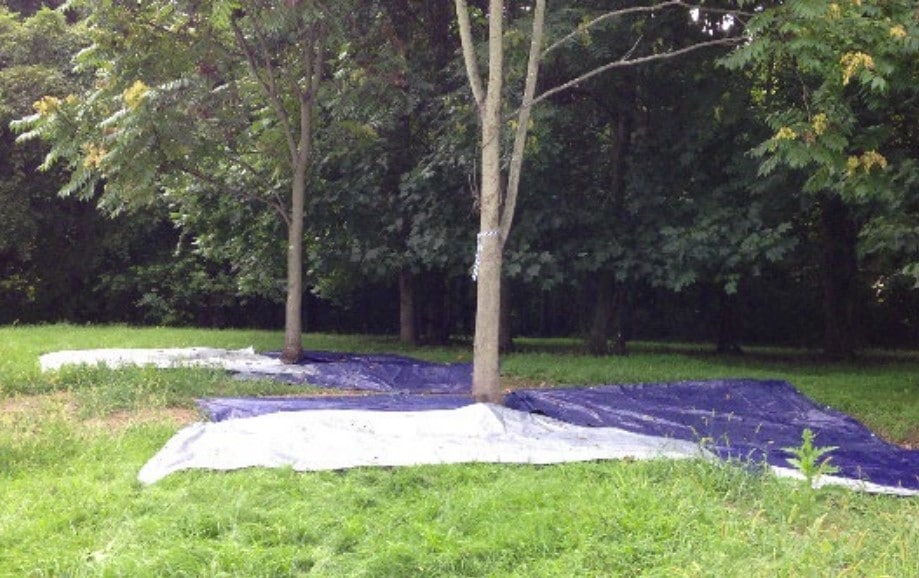PEST MANAGEMENT & INSECTICIDE TECHNOLOGY
Application Methods to Control the Spotted Lanternfly
Phil Lewis¹
¹Otis Laboratory, USDA APHIS PPQ S&T, Buzzards Bay, MA
Introduction
Spotted lanternfly, SLF, Lycorma delicatula, a sap feeding insect native to Taiwan and China, was first detected in the U.S. in 2014. Field populations continue to expand beyond the 14 county area currently under quarantine in southeastern Pennsylvania. Severe impacts by this insect have been noted.
The current control measure being employed by state and federal cooperators against SLF is a bark spray application of dinotefuran on tree of heaven (Ailanthus), the preferred host tree. The effectiveness of this control approach is readily apparent, especially later in the year when dead SLF adults can be found piled at the base of treated trees (Fig 1).

Figure 1. Dead and dying SLF adults at the base of a treated tree.
Methods
Various insecticide and application methods were compared during the 2017-18
field seasons to determine optimal treatments and to verify efficacy. Dead SLF
adults were counted on tarps positioned under the dripline of treated trees over a
six week period from late August to early October. Tarps were checked and cleaned
every 2-3 days during testing (Fig. 2).
Trunk injection treatments of dinotefuran, imidacloprid (Dinocide & Imicide 10%
formulations; JJ Mauget) and emamectin benzoate (Tree-age; Arborjet) were
compared to the standard SLF program treatment of a bark spray application of
dinotefuran (Safari or Transtect; Valent, Rainbow Scientific) using the maximum
label rate. Injection treatments were applied at 2mL of formulated product per
diameter inch of tree. In 2017 there were four trees treated with bark spray and two
trees for each of the trunk injectable products. In 2018 the number of trees used for
each injectable product was increased to five and all study trees were deep root
fertilized out to the dripline with ArborGreen Pro 30-10-7 in June by Davey Tree.

Figure 2. Tarp layout used to monitor
SLF mortality following treatments.

Figure 3. Dead SLF adults on a tarp.
Results
The emamectin product was tested only in 2017 as mortality under those trees on
most sample dates was not very different from the control group. However, adult
SLF are susceptible to both dinotefuran and imidacloprid applied as either an
injectable formulation or as a bark spray (Fig 3). In 2017 there were almost 28,000
dead SLF adults collected from 12 tarps. Populations increased almost 10-fold the
following year as there were over 252,000 dead SLF adults tallied from under 17
treated trees (same time period and research site).
Mortality data were highly variable over time (Fig 4) and also varied greatly by
individual tree, with some trees attracting and killing a disproportionate number of
SLF. A single tree in 2017 accounted for about 36% of the catch and three of the
most productive trees in 2018 made up 52% of the total (Fig 5.). The three highest
performing trees in 2017 were again among the most productive trees in 2018.

Figure 4. Average SLF adult mortality by date over a 6 week period in 2018.
Discussion
Spotted lanternfly seem to be susceptible to most insecticides and were readily killed after feeding on trees treated with either
dinotefuran or imidacloprid. It is evident that these insects move around a lot, as SLF adults were coming in from untreated
trees on the property and dead insects were continually landing on the tarps over a six week period. Standard errors noted in
Figure 4 highlight the extreme variability in catch within treatment groups as there were only three dates where the Dinocide
treatment was different from the control (p < 0.05; asterisk) and a single instance where Dinocide was superior to the bark spray treatment (p < 0.01; ampersand). 2017 data had similar trends and it appears that SLF adults are more susceptible to
the Dinocide injection treatment and/or are killed faster and therefore more SLF end up on the tarps to be counted.
The variability in SLF adult catch among individual trees in 2018 is displayed in Figure 5 and was similar to results from 2017. Considering three trees caught over half the SLF adults over a six week period in the 2018 tests, there must be some factor in certain Ailanthus trees that draws or retains them. Two years of observations on the same property noted certain trees that were more heavily populated by SLF adults and this was consistent year to year. Others have also noted that SLF prefer certain Ailanthus trees on a property.

Figure 5. Total SLF adults collected under individual trees in 2018.
Another aspect of SLF adult behavior is
the reduction in SLF mortality numbers
by mid-September (Fig 4). The
Cooperband lab (Behavior section,
2018 Otis Annual report) has noted that
SLF females become reproductively
mature and begin to disperse for egg
laying at about this time.
Because of the variability in tree
attractiveness in 2017, all study trees
were fertilized in 2018 to see if levels of
nitrogen, phosphorus and potassium
(NPK) play a role in attracting SLF
adults. Tree foliage was analyzed prior
to fertilization and monthly between
August and October. There were no
significant differences in the NPK values
of individual trees or over time from
the four sample collections taken.
Values also did not differ between the
study trees and nearby, untreated
Ailanthus trees, so nutrient levels do
not appear to be a factor in how SLF
adults are selecting certain trees.
